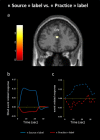The effect of verbal context on olfactory neural responses
- PMID: 23225581
- PMCID: PMC6869804
- DOI: 10.1002/hbm.22215
The effect of verbal context on olfactory neural responses
Abstract
Odor names refer usually to "source" object categories. For example, the smell of rose is often described with its source category (flower). However, linguistic studies suggest that odors can also be named with labels referring to categories of "practices". This is the case when rose odor is described with a verbal label referring to its use in fragrance practices ("body lotion," cosmetic for example). It remains unknown whether naming an odor by its practice category influences olfactory neural responses differently than that observed when named with its source category. The aim of this study was to investigate this question. To this end, functional MRI was used in a within-subjects design comparing brain responses to four different odors (peach, chocolate, linden blossom, and rose) under two conditions whereby smells were described either (1) with their source category label (food and flower) or (2) with a practice category label (body lotion). Both types of labels induced activations in secondary olfactory areas (orbitofrontal cortex), whereas only the source label condition induced activation in the cingulate cortex and the insula. In summary, our findings offer a new look at olfactory perception by indicating differential brain responses depending on whether odors are named according to their source or practice category.
Keywords: context; fMRI; olfaction; smell; verbal.
Copyright © 2012 Wiley Periodicals, Inc.
Figures





References
-
- Anderson AK, Christoff K, Stappen I, Panitz D, Ghahremani DG, Glover G, Gabrieli JD, Sobel N (2003): Dissociated neural representations of intensity and valence in human olfaction. Nature Neurosci 6:196–202. - PubMed
-
- Ashburner J, Friston K (2003): Spatial normalization using basis function In: Frackowiak RSJ, editor.Human Brain Function, 2nd ed. Amsterdam:Academic Press.
-
- Ayabe‐Kanamura S, Schicker I, Laska M, Hudson R, Distel H, Kobayakawa T, Saito S (1998): Differences in perception of everyday odors: A Japanese‐German cross‐cultural study. Chem Senses 23:31–38. - PubMed
-
- Bensafi M (2012): The role of the piriform cortex in human olfactory perception: Insights from functional neuroimaging studies. Chemosens Percept 5:4–10.
-
- Bensafi M, Rouby C, Farget V, Vigouroux M, Holley A (2002): Asymmetry of pleasant vs. unpleasant odor processing during affective judgment in humans. Neurosci Lett 328:309–313. - PubMed
Publication types
MeSH terms
LinkOut - more resources
Full Text Sources

